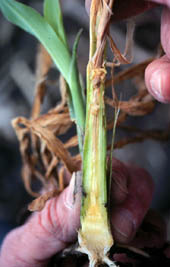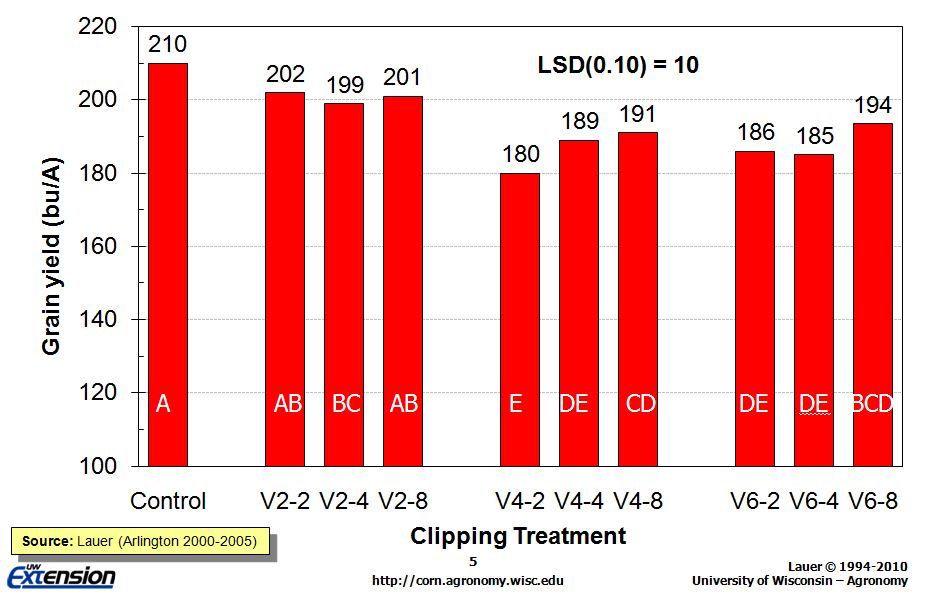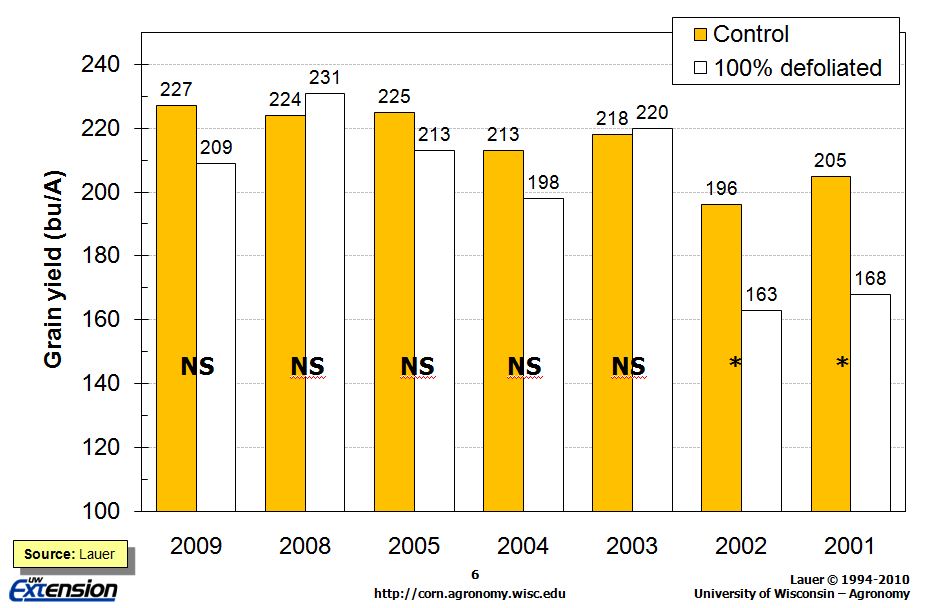Corn Replanting
Originally written February 1, 2006 | Last updated
March 14, 2014
UWEX Re-planting / Late planting
- A3353
Step 1: Determine plant population (use 1/1000
acre)
|
Row Spacing
|
Row Length
|
|
10"
|
52' 3"
|
|
15"
|
34' 10"
|
|
19"
|
27' 6"
|
|
30"
|
17' 5"
|
|
36"
|
14' 6"
|
|
38"
|
13' 9"
|
|
40"
|
13' 1"
|
Step 2: Evaluate plant health
Troubleshooting emergence problems early is critical in identifying
solutions and developing successful replant plans, if needed. Here's a
list of a few common things to look for if you encounter an emergence
problem in corn this spring.

|
|
A corn seedling stalk is split to show the growing point, the twisted
whorl of leaves, and the bacterial soft rot infection (the brown discoloration in
the of the stem).
|
Healthy corn has a creamish-white appearance to the roots and growing
point. Dark, discolored areas are typical symptoms of seedling diseases
problems. As corn starts to emerge, growers should carefully inspect
seedlings for symptoms of disease, especially in lower lying areas of fields
where ponding and saturated soils are more likely. It is more difficult to
diagnose disease damage on plants that also show abnormal growth caused by
cold soil conditions or by crusting of the soil surface. So, it is best to check these seedlings very closely for dark
brown or soft areas on seedling roots and shoots. Any discoloration indicates a problem that could worsen.
Seed rot or seed with low vigor: Symptoms are a poorly developed radicle (root) or coleoptile.
The coleoptile tip is
brown or yellow. Seeds and seedlings that are brown in color, are soft and
fall apart easily while digging may be dead or dying.
Seed and seedling diseases: Pythium and Fusarium are common fungi
that attack plants and cause these damping-off or seedling blight symptoms
under wet, cool conditions. Seeds and seedling roots or shoots that have
white to pinkish mold growing on them will likely die.
Step 3: Assess the unevenness of stands
Some factors that cause spatial and temporal plant variability:
- Planter Speed
- No seed present. May be due to planter malfunction or
bird or rodent damage. The latter often will leave some
evidence such as digging or seed or plant parts on the
ground.
- Skips associated with discolored and malformed
seedlings. May be herbicide damage. Note depth of planting
and herbicides applied compared with injury symptoms such as
twisted roots, club roots, or purple plants.
- Frost
- Seed has swelled but not sprouted. Often poor
seed-to-soil contact or shallow planting- seed swelled then
dried out. Check seed furrow closure in no-till. Seed may
also not be viable.
- Coleoptile (shoot) unfurled, leafing-out underground.
Could be due to premature exposure to light in cloddy soil,
planting too deep, compaction or soil crusting, extended
exposure to acetanilide herbicides under cool wet
conditions, combinations of several of these factors, or may
be due to extended cool wet conditions alone.
- Seeds hollowed out. Seed corn maggot or wireworm. Look
for evidence of the pest to confirm.
- Inter-plant competition for solar radiation, water and nutrients
- Low soil fertility
- Saturated and/or cool soils: May be due to soil moisture
and temperature variability within the seed zone. Poor seed
to soil contact caused by cloddy soils. Soil crusting. Other
conditions that result in uneven emergence already noted
above, including feeding by various grub species.
- Drought
Note patterns of poor emergence. At times they are associated
with a particular row, spray width, hybrid, field or residue
that may provide some additional clues to the cause. Often two
or more stress factors interact to reduce emergence where the
crop would have emerged well with just one present. Also, note
the population and the variability of the seed spacing.
Don't forget that corn may take up to 3 to 4 weeks to emerge
when soil conditions are not favorable (e.g. temperatures below
55 degrees F, inadequate soil moisture). As long as stands are
not seriously reduced, delayed emergence usually does not have a
major negative impact on yield. However, when delayed emergence
is associated with uneven plant development, yield potential can
be reduced.
Spatial Plant Variability - Distribution of plants in a row
Handout of plant spacing variability

- Currently receiving a lot of press. Claims of 20% yield increases if spacing variation
= 0
- Spacing variability affects yield when spacing standard deviation > 4.7 inches
- Further reading:
Lauer, Joseph G. and Mike Rankin. 2004.
Corn Response to Within Row Plant Spacing Variation. Agronomy Journal 96:1464-1468.
Temporal plant variability - eveness of emergence
One way to simulate eveness of stand and its effect on yield is to clip (or 'set
back') plants at various stages of growth by clipping all of the above gound
leaves on the plant. Corn grain yield is affected when 50% of the plants are clipped.

However, when 100% of the plants are clipped little impact on yield is observed
in most years.

Another method that simulates the effect of emergence on grain yield is planting
seed into a growing stand at various growth stages (see NCR344).
Step 4: Compare the yield of a reduced stand
to that of a replanted stand
|
Expected corn grain yield for various planting dates and harvest populations in Relative
Maturity zones of 70 to 95 days. Figures for shorter-season hybrids are in italics.
The actual Relative Maturities of short-and full-season hybrids vary with location
and soil type.
|
|
Harvest
|
Planting date
|
|
population
|
April 20
|
May 1
|
May 10
|
May 20
|
June 1
|
June 10
|
June 20
|
|
|
full
|
short
|
full
|
short
|
full
|
short
|
full
|
short
|
full
|
short
|
full
|
short
|
full
|
short
|
|
|
percent of expected yield
|
|
36000
|
96
|
82
|
100
|
89
|
97
|
89
|
86
|
82
|
63
|
65
|
39
|
46
|
5
|
18
|
|
34000
|
95
|
81
|
99
|
88
|
96
|
88
|
85
|
81
|
63
|
65
|
39
|
46
|
5
|
18
|
|
32000
|
94
|
80
|
98
|
87
|
95
|
87
|
85
|
80
|
62
|
64
|
38
|
45
|
5
|
18
|
|
30000
|
93
|
79
|
97
|
86
|
94
|
86
|
83
|
79
|
61
|
63
|
38
|
45
|
5
|
18
|
|
28000
|
91
|
78
|
95
|
85
|
92
|
84
|
82
|
78
|
60
|
62
|
37
|
44
|
5
|
18
|
|
26000
|
89
|
76
|
93
|
83
|
90
|
83
|
80
|
77
|
59
|
61
|
37
|
43
|
5
|
17
|
|
24000
|
87
|
75
|
91
|
81
|
88
|
81
|
79
|
75
|
58
|
59
|
36
|
42
|
5
|
17
|
|
22000
|
85
|
73
|
89
|
79
|
86
|
79
|
76
|
73
|
56
|
58
|
35
|
41
|
5
|
16
|
|
20000
|
82
|
70
|
86
|
76
|
83
|
76
|
74
|
70
|
54
|
56
|
34
|
40
|
4
|
16
|
|
18000
|
79
|
68
|
83
|
74
|
80
|
73
|
71
|
68
|
53
|
54
|
32
|
38
|
4
|
15
|
|
16000
|
76
|
65
|
80
|
71
|
77
|
70
|
69
|
65
|
50
|
52
|
31
|
37
|
4
|
15
|
|
14000
|
73
|
62
|
76
|
67
|
74
|
67
|
65
|
62
|
48
|
49
|
30
|
35
|
4
|
14
|
|
12000
|
69
|
59
|
72
|
64
|
70
|
64
|
62
|
59
|
46
|
47
|
28
|
33
|
4
|
13
|
|
10000
|
65
|
55
|
68
|
60
|
66
|
60
|
58
|
56
|
43
|
44
|
27
|
31
|
3
|
13
|
|
|
|
Expected corn grain yield for various planting dates and harvest populations in Relative
Maturity zones of 95 to 115 days. Figures for shorter-season hybrids are in italics.
The actual Relative Maturities of short-and full-season hybrids vary with location
and soil type.
|
|
Harvest
|
Planting date
|
|
population
|
April 20
|
May 1
|
May 10
|
May 20
|
June 1
|
June 10
|
June 20
|
|
|
full
|
short
|
full
|
short
|
full
|
short
|
full
|
short
|
full
|
short
|
full
|
short
|
full
|
short
|
|
|
percent of expected yield
|
|
36000
|
96
|
91
|
99
|
95
|
95
|
93
|
85
|
87
|
63
|
71
|
40
|
55
|
8
|
32
|
|
34000
|
97
|
92
|
100
|
96
|
96
|
94
|
85
|
87
|
63
|
72
|
40
|
56
|
8
|
32
|
|
32000
|
97
|
92
|
100
|
96
|
96
|
94
|
86
|
87
|
63
|
72
|
40
|
56
|
8
|
32
|
|
30000
|
96
|
92
|
100
|
96
|
96
|
94
|
85
|
87
|
63
|
72
|
40
|
56
|
8
|
32
|
|
28000
|
96
|
91
|
99
|
95
|
95
|
93
|
84
|
86
|
63
|
71
|
40
|
55
|
8
|
32
|
|
26000
|
94
|
89
|
97
|
93
|
93
|
92
|
83
|
85
|
62
|
70
|
39
|
54
|
8
|
31
|
|
24000
|
92
|
87
|
95
|
91
|
91
|
89
|
81
|
83
|
60
|
68
|
38
|
53
|
7
|
31
|
|
22000
|
89
|
85
|
92
|
88
|
89
|
87
|
79
|
81
|
58
|
66
|
37
|
51
|
7
|
30
|
|
20000
|
86
|
82
|
89
|
85
|
85
|
84
|
76
|
78
|
56
|
64
|
36
|
49
|
7
|
29
|
|
18000
|
82
|
78
|
85
|
81
|
82
|
80
|
72
|
74
|
54
|
61
|
34
|
47
|
7
|
27
|
|
16000
|
78
|
74
|
80
|
77
|
77
|
76
|
68
|
70
|
51
|
58
|
32
|
45
|
6
|
26
|
|
14000
|
73
|
69
|
75
|
72
|
72
|
71
|
64
|
65
|
47
|
54
|
30
|
42
|
6
|
24
|
|
12000
|
67
|
64
|
69
|
66
|
67
|
65
|
59
|
60
|
44
|
50
|
28
|
38
|
5
|
22
|
|
10000
|
61
|
58
|
63
|
60
|
60
|
59
|
54
|
55
|
40
|
45
|
25
|
35
|
5
|
20
|
Step 5: Calculate replanting costs
Step 6: Factor in risks of replanting
- Soil fertility
- Starter fertilizer may be needed with full-season hybrids planted late
- Pest control
- Weather influences
Further Reading
Grain Crop
Alternatives
Corn Replanting or Late-Planting Decisions
UWEX Bulletin A3353
Uneven emergence in corn NCR344